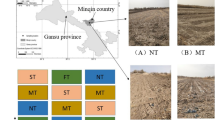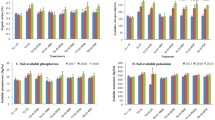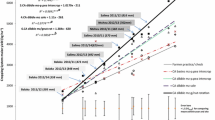Abstract
Worldwide, soil degradation due to erosion is still a major issue. Minimum tillage, intercropping, and alley cropping are important features of conservation agriculture and food security, but the farming communities are reluctant to accept these practices due to area reduction and plant competition. We investigated maize sole cropping (T1) as current farmers’ practice; T2: maize intercropped with chilies, tillage and fertilization; T3: maize-chili intercrop, mini. tillage, fertilization, Jack-bean relay cropping; T4: Like T3 but with hedges; T5 and T6 like T3 and T4, respectively, but without fertilization on Thai uplands during 2010 and 2011. Maize above ground biomass (AGB) was higher in T2 than T1 during both years. Light use efficiency (LUE) for AGB was 1.44–1.56 and 1.44–1.96 g DM MJ−1 in T4 during 2010 and 2011, 17–47% higher than T1, respectively. Land equivalent ratio was 1.23 and 1.17 in T2 while 1.28 and 1.21 in T4 during 2010 and 2011, respectively. Maize grain nitrogen (Ng) was significantly lower in unfertilized treatments. Intercropping with soil conservation enhanced land use efficiency with soil protection against erosion. Understanding spatial variations of LUE, Ng, as well as their impact on crop productivity are useful for fine-tuning crop management in conservation agriculture and sustainable land use on uplands.



Similar content being viewed by others
References
Awal MA, Koshi H, Ikeda T (2006) Radiation interception and use by maize/peanut intercrop canopy. Agric For Meteorol 139:74–83. https://doi.org/10.1016/j.agrformet.2006.06.001
Banik P, Sasmal T, Ghosal PK, Bagchi DK (2000) Evaluation of mustard (Brassica compestris Var. Toria) and legume intercropping under 1:1 and 2:1 row-replacement series systems. J Agron Crop Sci 185:9–14. https://doi.org/10.1046/j.1439-037X.2000.00388.x
Bedoussac L, Justes E (2010) Dynamic analysis of competition and complementarity for light and N use to understand the yield and the protein content of a durum wheat–winter pea intercrop. Plant Soil 330:37–54. https://doi.org/10.1007/s11104-010-0303-8
Burner DM, Brauer DK (2003) Herbage response to spacing of loblolly pine trees in a minimal management silvopasture in southeastern USA. Agrofor Syst 57:69–77. https://doi.org/10.1023/A:1022943224478
Campbell CS, Heilman JL, McInnes KJ, Wilson LT, Medley JC, Wu G, Cobos DR (2001) Seasonal variation in radiation use efficiency of irrigated rice. Agric For Meteorol 110:45–54. https://doi.org/10.1016/S0168-1923(01)00277-5
Chen Y, Li Y, Yu S, Yu Z (2002) Border effect and standardization of cropping patterns of wheat. J Triticeae Crops 23:68–71
Coussement T, Maloteau S, Pardon P et al (2018) A tree-bor-dered field as a surrogate for agroforestry in temperate regions: where does the water go? Agric Water Manag 210:198–207. https://doi.org/10.1016/j.agwat.2018.06.033
De Costa WAJM, Surenthran P (2005) Tree-crop interactions in hedgerow intercropping with different tree species and tea in Sri Lanka: 1. Production and resource competition. Agroforest Syst 63:199–209. https://doi.org/10.1007/s10457-005-1090-8
de Oliveira GL, de Oliveira ME, de Oliveira Macêdo E et al (2020) Effect of shading and canopy height on pasture of Andropogon gayanus in silvopastoral system. Agrofor Syst 94:953–962. https://doi.org/10.1007/s10457-019-00458-5
Edwards JT, Purcell LC, Vories ED (2005) Light interception and yield potential of short-season maize (Zea mays L.) hybrids in the Midsouth. Agron J 97:225–234. https://doi.org/10.2134/agronj2005.0225
Gallagher JN, Biscoe PV (1978) Radiation absorption, growth and yield of cereals. J Agric Sci 91:47–60. https://doi.org/10.1017/S0021859600056616
Garrett HE, McGraw RL, Walter WD (2009) Alley cropping practices. In: Garrett HEG (ed) North American agroforestry: an integrated science and practice, 2nd edn. American Society of Agronom, Madison, pp 133–162. https://doi.org/10.2134/2009.northamericanagroforestry.2ed.c7
Garrity DP (2004) Agroforestry and the achievement of the Millennium Development Goals. Agrofor Syst 61–62:5–17. https://doi.org/10.1023/B:AGFO.0000028986.37502.7c
Gomes FJ, Pedreira BC, Santos PM et al (2020) Micro climate effects on canopy characteristics of shaded palisade grass pastures in a silvopastoral system in the Amazon biome of central Brazil. Eur J Agron 115:126029. https://doi.org/10.1016/j.eja.2020.126029
Hauggaard-Nielsen H, Ambus P, Jensen ES (2001) Interspecific competition, N use and interference with weeds in pea–barley intercropping. Field Crops Res 70:101–109. https://doi.org/10.1016/S0378-4290(01)00126-5
Hilger T, Keil A, Lippe M, Panomtaranichagul M, Saint-Macary C, Zeller M, Pansak W, Tuan VD, Cadisch G (2013) Soil conservation on sloping land: technical options and adoption constraints. In: Fröhlich HL, Schreinemachers P, Stahr K, Clemens G (eds) Sustainable land use and rural development in Southeast Asia: innovations and policies for mountainous areas. Springer, Berlin, pp 229–279
Hobbs PR, Sayre K, Gupta R (2008) The role of conservation agriculture in sustainable agriculture. Philos Trans R Soc 363:543–555
Hussain K (2015) Measuring and modelling resource use competition at the crop-soil-hedge interface on a hillside in Western Thailand. Dissertation, Uni-Hohenheim, Germany. http://opus.uni-hohenheim.de/volltexte/2015/1060/
Hussain K, Wongleecharoen C, Hilger T, Vanderborght J, Garré S, Onsamrarn W, Diels J, Kongkaew T, Cadisch G (2015) Combining δ13C measurements and ERT imaging: improving our understanding of competition at the crop-soil-hedge interface. Plant and Soil. https://doi.org/10.1007/s11104-015-2455-z
Hussain K, Wongleecharoen C, Hilger T, Ahmad A, Kongkaew T, Cadisch G (2016) Modelling resource competition and its mitigation at the crop-soil-hedge interface using WaNuLCAS. Agrofor Syst. https://doi.org/10.1007/s10457-015-9881-z
Hussain K, Ilyas A, Wajid A, Ahmad A, Mahmood N, Hilger T, Kongkaew T (2019) Alley cropping simulation: an opportunity for sustainable crop production on tropical uplands. Pak J Agri Sci 56:109–112
Iio A, Hikosaka K, Anten NPR, Nakagawa Y, Ito A (2014) Global dependence of field-observed leaf area index in woody species on climate: a systematic review. Glob Ecol Biogeogr 23:274–285. https://doi.org/10.1111/geb.12133
International food policy research institute (IFPRI) (2003) 2020 projections, international model for policy analysis of agricultural commodities and trade (IMPACT) special project; global trends in food supply and demand. IFPRI, Washington D.C.
Jose S, Dollinger J (2019) Silvopasture: a sustainable livestockproduction system. Agrofor Syst 93:1–9. https://doi.org/10.1007/s10457-019-00366-8
Kanniah KD, Beringer J, North P, Hutley L (2012) Control of atmospheric particles on diffuse radiation and terrestrial plant productivity: a review. Prog Phys Geogr 36:209–237. https://doi.org/10.1177/0309133311434244
Khaliq T, Ahmad A, Hussain A, Ranjha A, Ali M (2008) Impact of nitrogen rates on growth, yield, and radiation use efficiency of maize under varying environments. Pak J Agric Sci 45:1–7
Li Q, Chen Y, Wu W, Yu S, Zhou X, Dong Q (2006) Effects of straw mulching and irrigation on solar energy utilization efficiency of winter wheat farmland. J Appl Ecol 17:243–246
Liu T, Song F, Liu S, Zhu X (2012) Light interception and radiation use efficiency response to narrow-wide row planting patterns in maize. Aust J Crop Sci 6:506–513
Miller A, Pallardy S (2001) Resource competition across the crop-tree interface in a maize-silver maple temperate alley cropping stand in Missouri. Agrofor Syst 53:247–259. https://doi.org/10.1023/A:1013327510748
Nascimento HLB do, Pedreira BC, Sollenberger LE et al (2019) Physiological characteristics and forage accumulation of grazed Marandu palisade grass (Brachiaria brizantha) growing in monoculture and in silvopasture with Euca-lyptus urograndis. Crop Pasture Sci 70:384. https://doi.org/10.1071/CP18403
Nyaga J, Muthuri CW, Barrios E et al (2019) Enhancing maize productivity in agroforestry systems through managing competition: lessons from smallholders’ farms, Rift valley, Kenya. Agrofor Syst 93:715–730. https://doi.org/10.1007/s10457-017-0169-3
Panozzo A, Bernazeau B, Desclaux D (2020) Durum wheat in organic olive orchard: good deal for the farmers? Agrofor Syst 94:707–717. https://doi.org/10.1007/s10457-019-00441-0
Pansak W, Dercon G, Hilger T, Kongkaew T, Cadisch G (2007) 13C isotopic discrimination: a starting point for newinsights in competition for nitrogen and water under contour hedgerow systems in tropical mountainous regions. Plant Soil 298:175–189. https://doi.org/10.1007/s11104-007-9353-y
Pansak W, Hilger T, Dercon G, Kongkaew T, Cadisch G (2008a) Temporal impact of soil conservation on crop production and soil fertility in the highlands of NE Thailand. In: Blum WEH, Gerzabek MH, Vodrazka M (eds). Book of abstracts. Paper presented at the EUROSOIL, Annual conference of the European Society of Soil Science, Vienna, Austria, p 319. http://www.ifab-hamburg.de/documents/39_abstracts.pdf
Pansak W, Hilger TH, Dercon G, Kongkaew T, Cadisch G (2008b) Changes in the relationship between soil erosion and N loss pathways after establishing soil conservation systems in uplands of Northeast Thailand. Agric Ecosyst Environ 128:167–176. https://doi.org/10.1016/j.agee.2008.06.002
Pansak W, Hilger T, Lusiana B, Kongkaew T, Marohn C, Cadisch G (2010) Assessing soil conservation strategies for upland cropping in Northeast Thailand with the WaNuLCAS model. Agrofor Syst 79:123–144. https://doi.org/10.1007/s10457-010-9290-2
Passioura JB (2002) Soil conditions and plant growth. Plant Cell Environ 25:311–318. https://doi.org/10.1046/j.0016-8025.2001.00802.x
Philip JS, Neil IH, Patricia M, Gudeta WS, Festus KA, Julia W, Fergus S (2017) Accurate crop yield predictions frommodelling tree-crop interactions in gliricidia–maize agro-forestry. Agric Syst 155:70–77
Purcell LC, Ball RA, Reaper JD, Vories ED (2002) Radiation use efficiency and biomass production in soybean at different plant population densities. Crop Sci 42:172–177. https://doi.org/10.2135/cropsci2002.1720
Stewart DW, Costa C, Dwyer LM, Smith DL, Hamilton RI, Ma BL (2003) Canopy structure, light interception, and photosynthesis in maize. Agron J 95:1465–1474. https://doi.org/10.2134/agronj2003.1465
Surki AA, Munir SS, Sinha F, Ramin I, Asghar M (2020) The competitive effect of almond trees on light and nutrients absorption, crop growth rate, and the yield in almond–cereal agroforestry systems in semi-arid regions. Agrofor Syst 94:1111–1122. https://doi.org/10.1007/s10457-019-00469-2
Tsubo M, Walker S, Mukhala E (2001) Comparisons of radiation use efficiency of mono-/inter-cropping systems with different row orientations. Field Crops Res 71:17–29. https://doi.org/10.1016/S0378-4290(01)00142-3
Tuan VD et al (2014) Mitigation potential of soil conservation in maize cropping on steep slopes. Field Crops Res 156:91–102. https://doi.org/10.1016/j.fcr.2013.11.002
Yang T, Zhu Y, Duan ZP et al (2020) Root distribution and productivity in a poplar tree + alfalfa silvopastoral system in northwest China’s Xinjiang Province. Agrofor Syst 94:997–1010. https://doi.org/10.1007/s10457-019-00466-5
Zhang W, Wang BJ, Gan YW et al (2019) Different tree age affects light competition and yield in wheat grown as a companion crop in jujube-wheat agroforestry. Agrofor Syst 93:653–664. https://doi.org/10.1007/s10457-017-0160-z
Acknowledgements
We would like to thank KU Leuven for funding field research under Project OT/07/045, the University of Agriculture, Faisalabad for supporting first author stay in Germany and the Forschungs Zentrum Jülich GmbH for providing the equipment. Finally, we would like to thank Prof. Thanuchai Kongkaew from Kasetsart University, Bangkok (who passed away just after the completion of project) for his support during field experiments.
Author information
Authors and Affiliations
Corresponding author
Additional information
Publisher's Note
Springer Nature remains neutral with regard to jurisdictional claims in published maps and institutional affiliations.
Rights and permissions
About this article
Cite this article
Hussain, K., Ilyas, A., Wongleecharoen, C. et al. Sustainable land use options for optimum resources use in maize based cropping system on uplands of Western Thailand. Agroforest Syst 94, 2289–2300 (2020). https://doi.org/10.1007/s10457-020-00550-1
Received:
Accepted:
Published:
Issue Date:
DOI: https://doi.org/10.1007/s10457-020-00550-1




